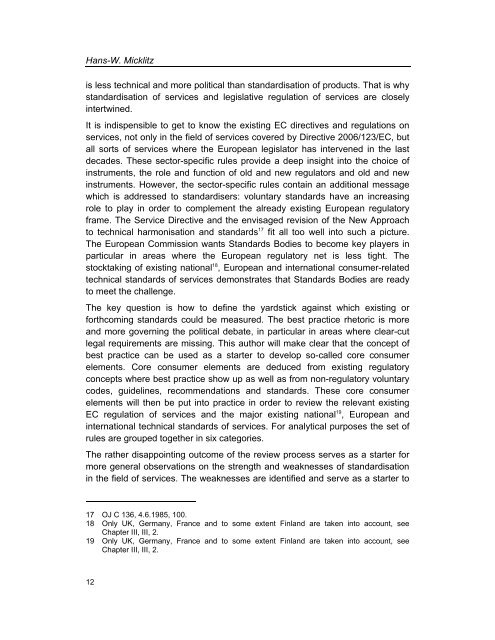Services Standards: Defining the Core Consumer Elements ... - ANEC
Services Standards: Defining the Core Consumer Elements ... - ANEC
Services Standards: Defining the Core Consumer Elements ... - ANEC
Create successful ePaper yourself
Turn your PDF publications into a flip-book with our unique Google optimized e-Paper software.
Hans-W. Micklitz<br />
is less technical and more political than standardisation of products. That is why<br />
standardisation of services and legislative regulation of services are closely<br />
intertwined.<br />
It is indispensible to get to know <strong>the</strong> existing EC directives and regulations on<br />
services, not only in <strong>the</strong> field of services covered by Directive 2006/123/EC, but<br />
all sorts of services where <strong>the</strong> European legislator has intervened in <strong>the</strong> last<br />
decades. These sector-specific rules provide a deep insight into <strong>the</strong> choice of<br />
instruments, <strong>the</strong> role and function of old and new regulators and old and new<br />
instruments. However, <strong>the</strong> sector-specific rules contain an additional message<br />
which is addressed to standardisers: voluntary standards have an increasing<br />
role to play in order to complement <strong>the</strong> already existing European regulatory<br />
frame. The Service Directive and <strong>the</strong> envisaged revision of <strong>the</strong> New Approach<br />
to technical harmonisation and standards 17 fit all too well into such a picture.<br />
The European Commission wants <strong>Standards</strong> Bodies to become key players in<br />
particular in areas where <strong>the</strong> European regulatory net is less tight. The<br />
stocktaking of existing national 18 , European and international consumer-related<br />
technical standards of services demonstrates that <strong>Standards</strong> Bodies are ready<br />
to meet <strong>the</strong> challenge.<br />
The key question is how to define <strong>the</strong> yardstick against which existing or<br />
forthcoming standards could be measured. The best practice rhetoric is more<br />
and more governing <strong>the</strong> political debate, in particular in areas where clear-cut<br />
legal requirements are missing. This author will make clear that <strong>the</strong> concept of<br />
best practice can be used as a starter to develop so-called core consumer<br />
elements. <strong>Core</strong> consumer elements are deduced from existing regulatory<br />
concepts where best practice show up as well as from non-regulatory voluntary<br />
codes, guidelines, recommendations and standards. These core consumer<br />
elements will <strong>the</strong>n be put into practice in order to review <strong>the</strong> relevant existing<br />
EC regulation of services and <strong>the</strong> major existing national 19 , European and<br />
international technical standards of services. For analytical purposes <strong>the</strong> set of<br />
rules are grouped toge<strong>the</strong>r in six categories.<br />
The ra<strong>the</strong>r disappointing outcome of <strong>the</strong> review process serves as a starter for<br />
more general observations on <strong>the</strong> strength and weaknesses of standardisation<br />
in <strong>the</strong> field of services. The weaknesses are identified and serve as a starter to<br />
17 OJ C 136, 4.6.1985, 100.<br />
18 Only UK, Germany, France and to some extent Finland are taken into account, see<br />
Chapter III, III, 2.<br />
19 Only UK, Germany, France and to some extent Finland are taken into account, see<br />
Chapter III, III, 2.<br />
12
















